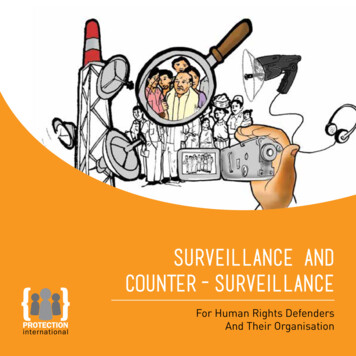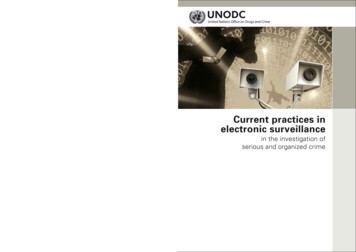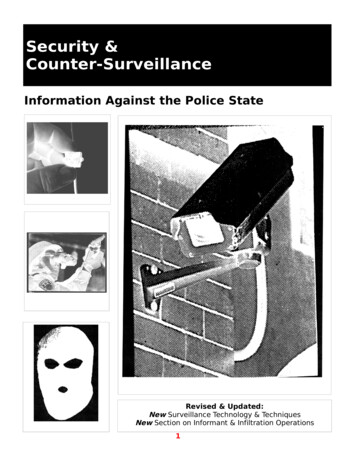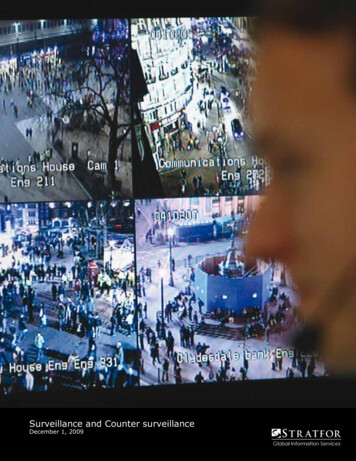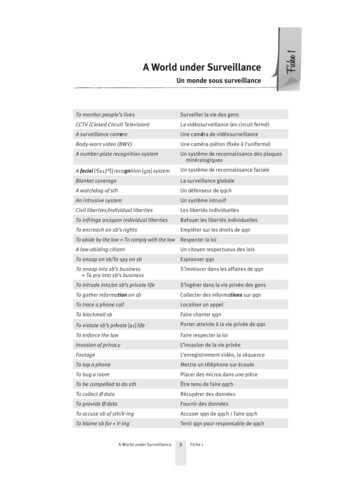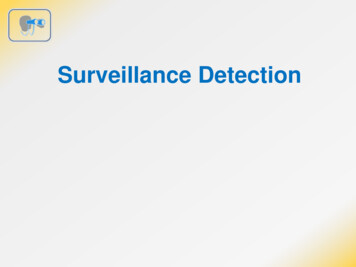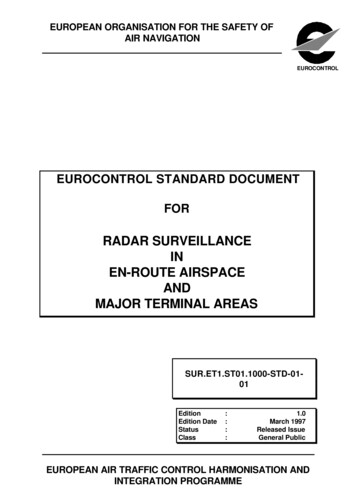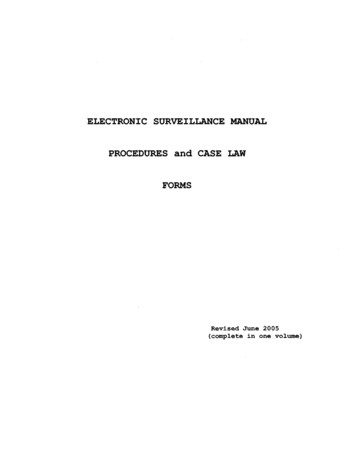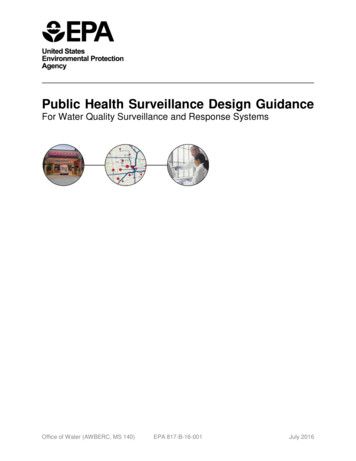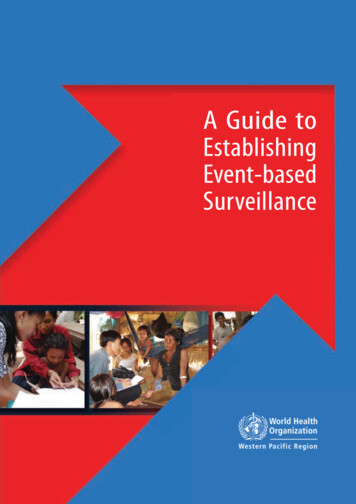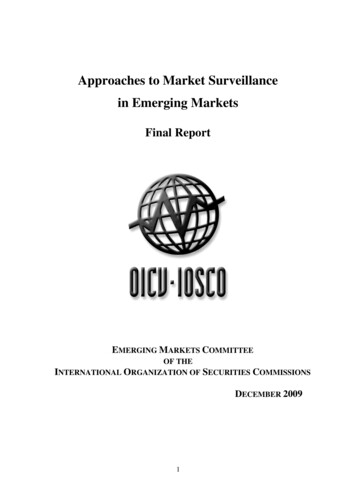
Transcription
Approaches to Market Surveillancein Emerging MarketsFinal ReportEMERGING MARKETS COMMITTEEOF THEINTERNATIONAL ORGANIZATION OF SECURITIES COMMISSIONSDECEMBER 20091
CONTENTSChapterPageChapter 1Objective and Approach3Chapter 2Approach of market surveillance in emerging markets2.1 Objective of Market Surveillance2.2 Responsibility for conducting market surveillance2.3 Surveillance systems and mechanisms2.4 Supplementary efforts2.5 Human capital and surveillance skills2.6 Interventions and enforcement2.7 Inter-market surveillance2.8 Cooperation and information-sharing arrangements555899101112Chapter 3Regulatory issues affecting market surveillance3.1 Changing landscape of surveillance14143.2 Making a case for market misconduct3.3 Striking the balance163.3.1 Skills vs. technology183.3.2 Market integrity vs. Market liquidity19Chapter 43.4 Inter-market surveillance193.5 Impact of demutualisation on surveillance20Conclusion23References252
Chapter 1: Objective and ApproachBackgroundThe Emerging Markets Committee (EMC) approved a mandate to examine theapproaches to market surveillance in emerging markets to be conducted by the EMCWorking Group on Regulation of Secondary Markets.This report examines the current approaches adopted by exchanges and/or regulatorsin conducting surveillance of markets. These include the role of the regulator versusthe exchange in conducting the surveillance function, surveillance systems andmechanisms used, the importance of human capital and surveillance skills andsupplementary efforts to complement the surveillance function.This report also examines the current methods used to intervene once market abuse isdetected and international cooperation with foreign exchanges and/or regulators onmatters involving market surveillance.It is also the intention of this report to provide emerging market regulators with agreater understanding of the key regulatory issues and challenges affecting marketsurveillance, and identify critical issues specific to emerging markets that could shaperegulatory responses.Survey Coverage and ResponsesA project team1, led by the Securities Commission Malaysia, gathered information forthis report via a survey questionnaire distributed to all IOSCO EMC members.The survey questionnaire comprised 31 questions which broadly covered theapproaches to surveillance/monitoring, surveillance tools and other resources used forsurveillance, and international co-operation.The survey questionnaire was formulated with a view to ascertaining the critical andcore issues experienced by emerging markets in relation to their approaches to marketsurveillance. These include: 1The current approaches - The survey sought to identify the current approachesadopted by the exchanges and/or regulators to monitor and detect adversesituations in their markets. The role of the regulator and/or the exchange inrelation to market surveillance was also reviewed.Project team members comprised regulators from China, Dubai, Brazil, India, Poland, SriLanka, South Africa and Thailand.3
Key regulatory issues and challenges - The survey sought to gatherinformation from emerging market regulators on regulatory issues andchallenges which may arise when detecting market irregularities. Regulatory reforms - The survey sought to identify and highlight perspectivesfrom various emerging market regulators on some of the key initiatives takenin achieving their objective of maintaining a fair and effective tradingenvironment.Responses were received from 32 jurisdictions2. In terms of geographical spread,there were 10 responses from Asia, 10 from Europe, 3 from South America, 5 fromAfrica and 4 from the Middle East.A summary of the survey responses was discussed at the EMC meeting in Marrakechin October 2008. At the Working Group meetings in Paris and Marrakech, the groupalso received feedback from exchanges in developed markets, including Euronext andthe London Stock Exchange.2Responses were received from the IOSCO ordinary members from Brazil, Bulgaria, Chile,China, Chinese Taipei, Croatia, Czech Republic, Dubai IFC, Egypt, El Salvador, Hungary,India, Indonesia, Korea, Lithuania, Macedonia, Malaysia, Morocco, Nigeria, Oman, Pakistan,Papua New Guinea, Poland, Romania, Slovenia, South Africa, Sri Lanka, Tanzania, Thailand,Turkey, Tunisia, and United Arab Emirates. Responses from El Salvador and Tunisia were inSpanish and French, respectively.4
Chapter 2: Approach of market surveillance in emerging marketsIntroductionThe forces of globalisation of markets, technological advancement, integrated tradingactivities and the increasing pace of market innovation have led to enhanced crossborder distribution of products and movement of market participants. With greaterinter-linkages of markets worldwide comes the increasing challenge of detectingpossible market misconduct. Corporate scandals3 seem to be larger in scale and morefrequent in recent years. The complexity and inter-relationship of trades are moredifficult to detect and identify. Rogue traders seem to have a better understanding ofinternal processes within sophisticated risk management systems.Thereforeregulators globally have had to strengthen their surveillance, supervision and cooperative efforts to ensure they stay ahead of the game.This chapter focuses on a broad overview of the approaches of market surveillance inemerging markets, and aims to provide a better understanding of the currentsurveillance landscape in emerging markets.2.1Objective of Market SurveillanceMarket integrity is a core regulatory objective of securities regulators, and is criticalfor the well-functioning of any capital market. Having a transparent set of tradingrules which are effectively enforced where parties have access to the same amount ofinformation contemporaneously is critical in any market. The integrity of the marketis maintained through a combination of surveillance, inspection, investigation andenforcement of relevant laws and rules.Market surveillance, in particular, plays a significant role in anticipating the potentialvulnerabilities to a capital market. It is seen as a pre-emptive measure aimed atdetecting and deterring potential market abuse and avoiding disruptions to the marketfrom anomalous trading activity, including market and price manipulation, insidertrading, market rigging and front running.2.2Responsibility for conducting market surveillanceThe survey shows that market surveillance is either conducted by the regulator, theexchange or both the regulator and the exchange in parallel. In some instances, thesurveillance function is outsourced to an independent Self-Regulatory Organisation(SRO), with the regulator and the exchange focusing on other regulatory functionsand market development initiatives. This however, we note, is less prevalent in3Some market manipulation cases include Metallgesellschaft, Barings, Sumitomo, and Enron,and Société Générale.5
emerging market jurisdictions where SROs tend to be at a nascent stage ofdevelopment.The survey findings show that in two-thirds of emerging market respondents, marketsurveillance is conducted by both the regulator and the exchange over the equitymarket. In jurisdictions where this occurs, the regulator exercises both an oversightrole over the exchange‟s conduct of surveillance functions to ensure it performs itsfunctions effectively and conducts parallel monitoring in tandem with the exchange.Primary role of surveillance in emerging market survey respondentsExchange, 10%,Regulator, 23%Both regulatorand exchange,67%The findings further indicate that surveillance units at the regulator and the exchangetend to focus on different aspects of monitoring the market. The regulator conductsmarket surveillance largely to detect breaches of the law, while the exchange‟semphasis is on breaches of its rules and regulations. However, where suspectedbreaches of the law have been detected, the exchange tends to refer these cases to theregulator for further action.Where parallel monitoring is conducted by both the regulator and the exchange, thesurvey findings show that the regulator typically conducts surveillance the nexttrading day4, while the exchange conducts surveillance on a real-time basis. Thelatter includes monitoring price and volume movements in the market, brokerpositions, risk management and settlement processes.The survey shows there is close coordination and information-sharing mechanisms inplace between the regulator and exchange. Many emerging market exchanges reportto the regulator on a daily basis, including where there are observations on limit-down4For example, Poland, India, Thailand and Indonesia.6
counters, unusual movement in trading or where enforcement action has been taken.In emerging markets such as India where there are 19 exchanges in the country, inorder to promote effective and interaction between the regulator and these exchangeson surveillance, an Inter-Exchange Market Surveillance Group was established. Thegroup, headed by the Securities and Exchange Board of India (SEBI) discusses theimplementation of weekly caps, daily price bands, as well as deliberates on markettrends and other related issues. Similarly in Pakistan, an Inter Exchange SurveillanceCommittee (IESC) was established with representatives from three stock exchanges inthe country, together with the Securities Exchange Commission of Pakistan foreffective coordination of surveillance activities.As highlighted earlier, there are instances where the surveillance function isoutsourced to an SRO, but this is less common in emerging markets as compared tothe more developed markets. Where surveillance is outsourced to an SRO, theregulators exercise proper oversight arrangements over the SRO to ensure fair andorderly markets.The Toronto Stock Exchange and TSX Venture Exchange outsourced marketsurveillance to an SRO recognised by the OSC, the Investment Industry RegulatoryOrganization of Canada (IIROC), which monitors all trading on both exchanges. TheIIROC uses real-time surveillance systems to ensure that transactions are done incompliance with market integrity rules. With a third party handling both surveillanceand participant discipline, TSX Markets' professionals focus more on providingexceptional trading products and service to domestic and international participants. Inthe US, two SROs, namely NYSE Regulation5 and the Financial Industry RegulatoryAuthority (FINRA6) have entered into agreement with ten7 U.S. exchanges tostrengthen investor protection by consolidating the surveillance, investigation andenforcement of insider trading in securities. The agreement allows NYSE Regulationand FINRA to implement across markets their state of the art insider tradingsurveillance and investigation programs for all listed securities in the US. As a result,5NYSE Regulation, Inc. is a not-for-profit corporation dedicated to strengthening marketintegrity and investor protection. NYSE Regulation is a subsidiary of NYSE Euronext with aboard of directors that is comprised of a majority of directors unaffiliated with any otherNYSE board. As a result, NYSE Regulation is independent in its decision-making. Theorganization consists of three divisions: Market Surveillance, Enforcement and Risk, andListed Company Compliance. NYSE Regulation protects investors by enforcing marketplacerules and federal securities laws.6FINRA, the Financial Industry Regulatory Authority, is the largest non-governmentalregulator for all securities firms doing business in the United States. Created in 2007 throughthe consolidation of NASD and NYSE Member Regulation, FINRA is dedicated to investorprotection and market integrity through effective and efficient regulation and complementarycompliance and technology-based services.7American Stock Exchange, Boston Stock Exchange, CBOE Stock Exchange, Chicago StockExchange, International Securities Exchange, NASDAQ Stock Market, National StockExchange, New York Stock Exchange, NYSE Arca, Philadelphia Stock Exchange.7
potential insider traders, regardless of where they trade in the US, will be more readilyidentified in this new, more unified structure.2.3Surveillance systems and mechanismsWith millions of trades transmitted electronically every minute, surveillancemechanisms to detect any irregularities must also be equally developed. Surveyresponses show that emerging market regulators and authorities rely on a combinationof systems from relatively simple tools often built and maintained in-house by theinternal information technology department to more sophisticated real-time marketsurveillance systems developed by third-party vendors. These tools can be written tospot trading patterns that are difficult to detect manually.One of the common features of surveillance systems used by emerging markets areautomated surveillance tools that analyse trading patterns and are installed with acomprehensive alerts management system. These tools are able to track the positionsof alleged large readers, and detect market manipulation, front-running, fraud andtrade practice violations.The majority of respondents in the survey agree that real-time alerts allow theidentification and detection of unusual trading activities at a very early stage. Thecommon parameters used by emerging market regulators and exchanges includeabnormal price and volume movements, concentration of trading, large open interest,front running, insider trading, wash trades and synchronised trades. These alerts aretriggered when trading activities exceed parameters that have been defined byauthorities. On a broader aspect, other considerations taken on board by regulatorsinclude the types of industry, the price range of counters and the types of productstraded. For example, the trading of bonds is considered to be less volatile thanexchange traded funds and warrants.To avoid the proliferation of alert triggers, survey results show that alert parametersare established to cater for the respective markets it is intended to surveill. Whilesurveillance systems may be purchased from several different vendors, what appearsto be critical is the internal customisation of the alert parameters by the regulator orthe exchange themselves.Survey results indicate that authorities also rely significantly on market intelligenceand information provided by market participants, the media, the internet andcomplaints from the public as a source of information and to supplement its analysis.For example, information of a company facing insolvency will not surface in an alertsystem, and it is information sourced from third parties and pieced together that willoften build up a case for further investigation.8
Survey results show that a significant proportion of emerging market regulators arelooking towards enhancing their surveillance capabilities and re-engineering theirsurveillance systems, for example to find relationships among suspected tradingaccounts, to provide real-time alerts and graphical analysis, and to be able to moreeasily aggregate and manipulate large trading data. In Poland, the MarketSurveillance Application (ANG) is expected to be modernised and sophisticated newalerts will be introduced. Investors will also be given individual identificationnumbers which will improve fraud detection. Turkey and South Africa have ongoingprojects to improve inter-market surveillance systems on derivatives exchanges,Brazil is receiving funding from the Inter-American Development Bank to implementa more effective market surveillance system while South Africa is upgrading itsequities surveillance system to a more modern platform and is introducing enhancedsurveillance functionalities for its derivatives markets. In the Czech Republic, theCzech National Bank is looking at developing a new computer system for marketsurveillance. The new system will be able to store data on orders prior to it beingtraded on the market.2.4Supplementary effortsIn order for surveillance to be effective, survey results show that an important featureis to have in place a database or repository of information. The information containedin the database may include background information of the listed entity, itsshareholders and directors, historical trading pattern and relevant news. Informationcontained in the database will help analyse potential irregularities in the market andfacilitate the linking of the trades to possible market abusers. However in some cases,a number of regulators heavily depend on financial institutions and brokers to provideinvestors‟ personal information, which takes approximately 3 to 5 days to retrieve.In India, SEBI has an Integrated Market Surveillance System (IMSS) which has anonline data repository with the capacity to capture market transactions and referencedata from a variety of sources such as stock exchanges, clearing houses, depositoriesand others for the securities and derivatives market. The data generated through theIMSS assists SEBI in analysing relevant market behaviour and various scenarios. InChile, the SVS‟s surveillance system provides real-time information about securitiesbroker-dealers executing transactions on its own account or on behalf of a client. Inorder to identify the end-client, the SVS calls on the broker-dealer for information.2.5Human capital and surveillance skillsEmerging market regulators and exchanges recognise the limitations posed bysurveillance systems, irrespective of how advanced the system is. Further detailedand comprehensive analysis is often required to assess a combination of informationto identify a potential abuse that may not be obvious from information generated by asurveillance system.9
Authorities are dependent on the skills and expertise of staff conducting marketsurveillance. Survey results show that in-depth analysis and inquiries are required bysurveillance analysts to determine if the irregularity warrants a basis for referral forfurther investigation by the enforcement units at the regulator.While emerging market regulators have not identified specific skills sets required ofsurveillance staff, survey results highlight that the common skills that regulators andexchanges seek in surveillance analysts include data mining and analytical skills andthe ability to understand the mechanics of the electronic trading environment, i.e.trade flow and processes and to analyse and evaluate surveillance technologyprograms and procedures. In addition, maintaining a good contact of networks withthe industry in order to draw leads of potential market abuse and facilitate theunderstanding of market trends and market behaviour is a critical aspect tosupplement surveillance efforts.2.6Interventions and enforcementSurvey results show that surveillance units at the regulator and the exchange typicallyfocus their efforts on monitoring of the market. Where there are cases of possibleviolations of securities laws, these are subsequently referred to the investigation andenforcement units of the regulator.In Malaysia, the exchange maintains a close watch of any unusual movementsthrough the daily monitoring of market activity. Should it detect unusual marketactivity, the exchange will contact the listed entity concerned to explain the unusualmovements, and this is often followed up by a formal letter requesting the company toexplain the unusual price and/or volume movements of its counter. Should the shareprice continue to remain volatile, the exchange will initiate a market alert by issuing amedia release or posting an alert on its website. The exchange may also initiate anUnusual Market Activity query to the listed entity in question. These are seen as preemptive measures to keep the market informed and to warn investors to be cautious ininvesting in the company.Survey responses show that regulators also see the benefits of adopting a softenforcement approach via a caution letter to the listed entity in question or seekingclarification from its compliance officer or management through phone call or letteras more effective and preventative compared to the more formal enforcement actions.However, responses show that in cases of repeated activity or serious breach of thelaws, more stringent action is taken.In the case of addressing market instability, survey results reflect that emergingmarket regulators have powers to intervene and impose designation of the stock orsuspend trading. Most emerging markets also have circuit breakers for automatic10
suspension of trading following steep and rapid decline in share prices. Indicatorsthat are continuously monitored include irregular or sharp movements of the index,sharp decreases or increases in financing commitments and continuous breach ofexposure and/or margin limits by brokers. For example in China, under Article 180 ofits Securities Laws, when investigating market manipulation or insider trading, theChina Securities Regulatory Commission can restrict trading for up to 15 tradingdays. However, when the cases are complex, trading will be restricted will beextended for a further 15 days.2.7Inter-market surveillanceInter-market surveillance can be described as securities cross-listed in multiplemarkets, financial instruments (e.g. for options, warrants and futures) traded in onemarket with the underlying equities in another market or cross-market activities thatoccur across several markets in different jurisdictions. Inter-market surveillance canalso be described as surveillance between two product exchanges, namely securitiesand derivatives exchanges. With the increasing globalisation of financial markets,derivatives contracts are increasingly cross-listed on exchanges, with round the clocktrading. It is noted that 80% of survey respondents have a derivatives market in theirjurisdictions whilst some have a commodities exchange as well.Survey results show that 57% of survey respondents conduct inter-marketsurveillance. Unlike for securities exchanges where both the regulator and exchangeconduct parallel monitoring, for the derivatives exchange, the regulator tends to take amore oversight role whilst primary surveillance in the derivatives market lies with theexchange.Percentage of jurisdictions that conduct cross-marketsurveillanceNo cross-market surveillance43%Cross-market surveillanceconducted, 57%11
In jurisdictions where there is an active derivatives market, for e.g. Korea, crossmarket surveillance is conducted extensively. In 2005, the Market OversightCommission (MOC) of the Korea Stock Exchange (KRX) launched a cross-marketsurveillance system to detect unfair trading activities across cash and futures marketeasier, faster and more accurately. The system was designed to monitor the stocks onthe Korean Stock Exchange and Kosdaq. Its purpose was to weed out unfair tradingactivities such as price manipulation linking stocks, and futures and options. KRXalso uses a cross-market monitoring database that identifies if a trader operates in bothstock and futures markets.In Malaysia, the exchange‟s equity and derivatives surveillance units conduct regularmonthly investigations of possible domestic inter-market abuses by checking onpossible unusual pattern of price and volume movement against identities of marketparticipants. This is conducted by performing on-line monitoring of trading activitiesin respect of the underlying and its respective derivatives products. Information onany unusual trading activities and price movements are shared between both marketsand analysed to determine if there are any manipulative activities.2.8Cooperation and information-sharing arrangementsGiven the increasingly volatile nature of the global capital market, it is vital forregulators and/or exchanges to share information on surveillance activities as wellenhance cooperation and coordinate market oversight through formal arrangements.In relation to sharing of information to facilitate market oversight, IOSCO‟s TechnicalCommittee Report on Multi-Jurisdictional Information Sharing for Market Oversight8recommended the types of information that could be shared among regulators, on abilateral or multilateral basis, include participants joining or leaving the market,transaction information (e.g. for details of a traders‟ position, large positions, relatedOTC and cash positions, and trading by an issuers„ significant shareholders andofficers), specific trading limits (for example, price and position limits and any relatedchanges) and reports of abusive practices and illegal behaviour, including insidertrading activity involving remote market participants.The IOSCO Technical Committee Report on Commodity Futures Markets9 alsohighlighted the importance of developing information-sharing arrangements incommodity futures markets. These arrangements will facilitate the understanding ofthe roles of speculative and commercial activity in commodity futures markets,provide a better understanding of price formation on these markets, and detectmanipulative or other abusive trading by market participants.8April 20079March 200912
Virtually all survey respondents indicated that they have entered into cooperativearrangements with other authorities to share information for the purposes of securingcompliance with their respective laws whether through bilateral or multilateralagreements. These arrangements however tend to be broad-based in nature andtypically cover information-sharing primarily for the purposes of enforcement, andmay not be specific enough to address issues relating to market surveillance.Irrespective of whether there are formal MOUs or informal arrangements in place,survey respondents highlighted that additional types of information that would beuseful for authorities to share include beneficial account ownership, information lacklistedinvestors/intermediaries, and information of suspicious trading of shares dually listedon several markets.An example of a surveillance-specific agreement that has been entered into byregulators is the MOU entered into between the US Commodities and Futures TradingCommission and the Financial Services Authority, UK in 2006 on the exchange ofinformation in relation to routine surveillance of US and UK derivatives exchanges.The MOU highlights information to be shared between both regulators includingterms and conditions of each derivative contract or instrument, details of anexchange‟s market regulations such as position limits, reporting obligations and pricelimits, details of delivery rules and procedures or cash settlement provisions, generaldetails about market information collected and analysed and other details of tradinginformation.Survey results show that exchanges have themselves entered into information-sharingarrangements, be it bilaterally, or through multilateral arrangements such as theIntermarket Surveillance Group (ISG). The ISG, created in 1981, is a committeeconsisting of exchanges around the world that provides a framework for the sharing ofinformation and the coordination of regulatory efforts among exchanges tradingsecurities and related products to address potential inter-market manipulations andtrading abuses. It is noted however that only three out of the thirty emerging marketrespondents are signatories to the ISG10.Aside from information-sharing in respect of surveillance activities, cooperationamong regulators and exchanges may also extend to the sharing of information onsurveillance technologies and techniques, as well as emerging trends, practices andchallenges relating to surveillance issues. Enhanced engagement among regulatorsand exchanges on these areas is likely to result in improved surveillance efforts.10Dubai Mercantile Exchange, Korea Exchange, National Stock Exchange of India.13
Chapter 3: Regulatory issues affecting market surveillanceEmerging markets are attracting a greater diversity of players, including highleveraged investors, and investments in emerging markets are often form part ofsophisticated cross-market or cross asset strategies. According to statistics, emergingmarket companies make up 3.8 per cent of the Financial Times‟ list of the 500 largestglobal traded companies (FT500) and 4.6 per cent of the Dow Jones Global Index of2,500 companies. Research also indicates that the market capitalization of emergingmarket countries has more than doubled over the past decade, growing from less thanUS 2 trillion in 1995 and exceeded US 5 trillion in 2006, making up 12 percent ofworld market capitalisation.However, the increased competition and activity in cross-border transactions, theadvent of new products and development of market infrastructure together with thefrequency and magnitude of financial turbulence have made it increasinglychallenging for emerging market regulators to conduct market surveillance.Emerging market regulators and/or exchanges are finding the need to be more vigilantagainst potential market abuse and increasing exposure to global market risk. It isimportant therefore for emerging market regulators and exchanges to have theappropriate skills, technological capabilities and regulatory arrangements to conducteffective internal and cross-border surveillance of their markets.This chapter identifies key issues and challenges affecting market surveillance inemerging markets that could shape regulatory responses. It also intends to provideregulators with a greater understanding of surveillance approaches to detect adversesituations in markets and to pursue appropriate preventive actions to avoid disruptionto markets.3.1Changing landscape of surveillanceOver the years, there has been a significant rise in the trading activity and volume inmany emerging markets given the increasing opportunities that these markets present.Many of these markets have therefore moved from a relatively illiquid to a moreliquid trading environment.The increase in the sophistication and complexity of financ
Exchange, International Securities Exchange, NASDAQ Stock Market, National Stock Exchange, New York Stock Exchange, NYSE Arca, Philadelphia Stock Exchange. 8 potential insider traders, regardless of where they trade in the US, will be more readily identified in this new, more unified structure. 2.3 Surveillance systems and mechanisms With millions of trades transmitted electronically every .
